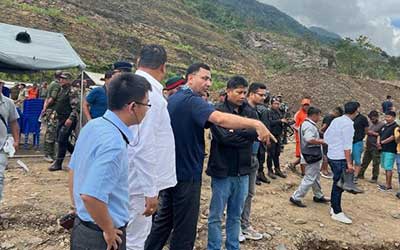Relevance: GS-3: Disaster and Disaster Management.
Key Phrases: TA, Landslides and types, NLSMP, NLRMS, NIDM, EIA, LRMS, Hazard Zonation Mapping;
Why in News?
- Tupul in Western Manipur recently saw one of the severest disasters in recent times. The death toll rose to 38 with 25 people still stuck inside the debris.
- The landslide hit a camp of the107 Territorial Army (TA) battalion affiliated with 11 Gurkha Rifles. Along with them, civilians consisting of contractual railway workers also perished.
Key Highlights
What are landslides?
- Landslides are hydro-geological hazards which involve the mass movement of rock, debris, or earth down a slope.
- There are 5 types of landslides
- Falls - Abrupt mass movement of the materials due to their dislodging.
- Topples - This occurs due to the influence of gravity or due to the forces exerted by neighbouring materials, the unit or units rotate forward around a point.
- Slides - This happens on a slope when materials slide to the lower area.
- Spreads - This happens on a relatively level area or on areas with a gradual slope.
- Flows - These are landslides that involve the movement of material down a slope in the form of a fluid.
Manipur Landslide
- The landslide has caused an accumulation of debris on the banks of the
Ijei River.
- This has caused a rise in the levels of the river.
- Breach of the dam-like structure will lead to submergence of the surrounding low-lying areas causing further death and destruction in this area.
- Heavy rains have further deteriorated rescue efforts and increased the possibility of landslides in surrounding areas.
- As per National Landslide Susceptibility Mapping Project, the Tupul area was marked as susceptible to landslides. Even then, the railway yard project was given a go-ahead.
Landslides in India
- Approx 15% of India’s areas are prone to landslides.
- 2-major regions which are prone to landslides are
- The Himalayan Region
- These are prone to landslides due to seismicity (Tectonically active).
- Unstable rock structure increases their vulnerability.
- The Western Ghats
- Due to heavy downpours from Monsoon, this area becomes prone to landslides.
- Further, heavy construction and subsequent change in land use patterns also add to the vulnerability.
- The Himalayan Region
- Reasons for Landslides
- Natural Reasons
- Earthquake
- Excessive Rainfall - eg. Uttarakhand cloudburst in 2013 caused landslide
- Anthropogenic Reasons
- Unsustainable Infrastructure Development
- Deforestation
- Mining
- Unsustainable Tourism
- Natural Reasons
Actions to check Landslide becoming a disaster
- National Lanslide Risk Management Strategy (2019)
- It covers various aspects of Disaster risk management such as hazard mapping, monitoring, and early warning systems.
- National Landslide Susceptibility Mapping Project
- It has been conducted by the Geological Survey of India.
- It was formally launched in 2014.
- Aim - To create a dynamic National Landslide Susceptibility Geodatabase for India.
- National Institute of Disaster Management (NIDM)
- It provides disaster management and disaster risk reduction capacity-building support to various national and state-level authorities.
- NDMA Guidelines on Landslide Hazard Management (2009)
- National Disaster Management Agency has published these guidelines
in order to ensure comprehensive disaster mitigation and planning.
- Create Hazard zonation maps to delineate areas susceptible to landslides.
- An autonomous centre for research and study in landslide management should be established.
- Encouraging implementation of successful landslide remediation and mitigation technologies.
- Training of Geoengineers and Geoscientists to develop a research ecosystem for enhanced preparedness against landslides.
- National Disaster Management Agency has published these guidelines
in order to ensure comprehensive disaster mitigation and planning.
Successful Technological Intervention
- Amrita Vishwa Vidyapeeth deployed a wireless sensor-based
landslide detection system
- In Kerala in 2009
- In Sikkim in 2018
- This intervention has delivered many successful warnings.
Way Forward
Structural Measures
- Afforestation-
- Especially on slopes as part of the integrated watershed management programme.
- Use the surface vegetative cover to bind the soil particles and decrease the velocity of flowing water.
- Preserving the current vegetation
- Checking forest fires by stopping Jhum cultivation.
- Grazing should be restricted.
- Engineering structures should be constructed to stabilise slopes
- Buttress beams
- Retaining walls
- Anchors
- Net of Steel Wires
Non-Structural Measures
- Better Planning
- Mandatory EIA (Environmental Impact Assessment) of the
infrastructure projects before commencing the work.
- Sufficient soil and stability tests must be performed before permitting a project
- Declaration of ESZ (eco-sensitive zones) where mining and other industrial activities are banned.
- Hazard mapping of the region to identify the most vulnerable zones and take measures to safeguard them.
- Local people should be involved in the sustainable development plan of the regions.
- Permanent Assessment Team should aid in better dynamic planning.
- Mandatory EIA (Environmental Impact Assessment) of the
infrastructure projects before commencing the work.
- Better Disaster response
- Pending Lanslide Risk Mitigation Scheme (LRMS) must be brought in.
- LDMF (Local Disaster Management force) for quick relief and safety of the people affected by landslides.
- Teaching people about landslides & ways to mitigate them.
Conclusion
- The developmental pressures in underdeveloped regions (like northeastern states) must be accommodated with ecological concerns and the limitation imposed by nature. The only way forward is to respect nature and grow along with it and not against it.
Source: The Hindu
Mains Question:
Q. What are Landslides? With reference to recent events of landslides mention challenges of Disaster management in case of landslides? Also, Suggest a suitable way forward.








